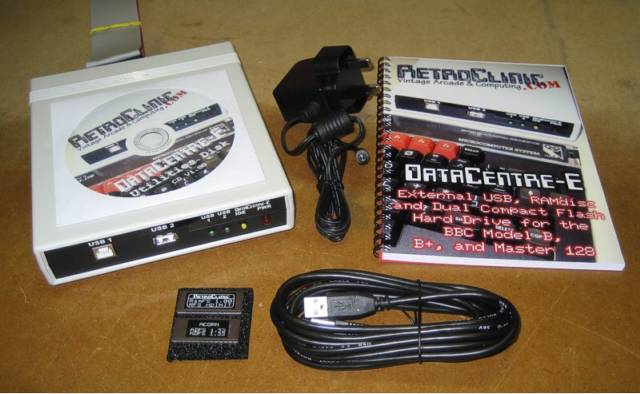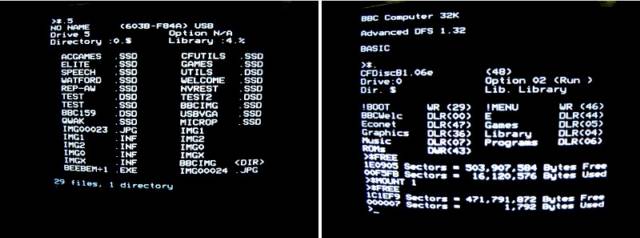
[Back ]
Mark Haysman described the BBC External Datacentre USB kit kit in an ebay auction (slightly edited) as:
DataCentre is a new 5 in 1 upgrade for the BBC Computer range from RetroClinic. It is a new leap forward for the BBC, bringing the connectivity of USB to the BBC Micro for use not just as a storage medium, but as a new way to connect modern hardware to your vintage machine.
The external version of the DataCentre system provides all the functions of the internal version, with the convienence of having the unit housed in a separate box - no internal fitting, and easy to swap between machines, and it looks right at home next to a Beeb, with it's matching cream plastic case.
- USB Host Controller, allowing connection of virtually any USB device including Flash Drives, Keyboards, Mice etc.
- USB Slave Port, allowing connection directly to your PC
- 1 Megabyte RAM for use by drivers, filing systems or the user.
- 64K Byte Non-Volatile RAM, used as a small RAM Drive for storing commonly used programs and utilities.
- Dual Compact Flash slots, for use by the ADFS system as up to 4 large hard drives, separate from the USB storage
The DataCentre is both simple to use for the first time user, and highly programmable by those with the knowledge. It cuts out the extra step common to all other storage systems for the BBC, that of the "transfer software" on the PC. With the DataCentre system, you no longer need any software on the PC whatsoever.
How does it work? You simply use any USB storage drive, of any capacity, be that a solid state Flash Drive, or a conventional Hard Drive in a USB Enclosure, and as long as it is formatted with the FAT or FAT32 filing system, it will be recognised. Most modern PCs, Macintoshes and Linux based machines will automatically recognise such a drive. You then download the software you want directly to it, or onto your PC hard drive and then drag the files across.
Once on the USB drive, this is simply inserted into DataCentre, and the BBC can now see all those files. With a single command, the image can be imported either to one of the 4 available RAM Drives, or directly onto a Floppy Disk if you have a floppy drive and interface. You can then go on to play the game, or modify that disk image whilst on floppy or in the RAM drive, or even use your own floppy discs, and export them back to the USB drive in one of two standard universal formats, known as SSD or DSD. These images can then be immediately used on the PC by plugging the Drive back into the PC USB port, either to upload to your website, or use in an emulator, or to archive on CD etc.
DataCentre doesn't restrict you like other MMC based systems. There's no limit to the size of device you can use, be it the latest 64GB USB Flash drives, or a 2TB Hard drive in a USB enclosure. No hunting to find old obsolete cards and a reader to go with them, USB sticks are the accepted standard medium for PCs, and with DataCentre, your Beeb can read them too. The mains adaptor supplied with the system provides enough power to allow you to connect an external "USB Powered" Hard Drive, and can supply power though a hub, up to 1 Amp.
The Compact Flash System. The DataCentre-E unit is also equipped with 2 Compact Flash slots. You can use either one, or both, to provide up to 2GB of online storage for ADFS, and use it in exactly the same way as Acorn designed for the original Winchesters. The system is fully backwards compatible with my existing CF Hard Drive system, so if you have one with several cards of software, they can simply be plugged into the DataCentre-E and will work as they did before.
Whilst the USB and RamFS system required no transfer software to get your images onto the Beeb, for the Compact Flash system, several programs are supplied on the CD to aid in getting your software onto the CF system. These specially written programs allow you to plug the CF card into your PC, via any USB Multi Card Reader, and take an image of the card for backup purposes, and write the image back to the same card, or another one of the same size. The Image these programs create are fully compatible with Jon Welch's ADFS Explorer, which allows you to load the image, browse it, add and delete files from downloaded floppy disk images, change the size of the drive for larger CF cards, manipulate it in almost any way you wish. You can then save that image, and reload it back to a CF card, and presto, your files are instantly ready to use on your Beeb in ADFS. And as it's an external unit, no opening the lid everytime you want to change card either! The backup and restore programs are supplied free with the kit, but DFS & ADFS Explorer are shareware, and whilst trial versions of both are included on the CD, they require a small registration fee to the Author for full functionality, please see his website for details. Sample hard drive images containing a selection of public domain software and games are also on the CD for you to try and use as a basis for your system. You can also use the USB system to transfer software directly onto the CF Hard Drive using the Beeb, if you prefer to do it that way.
You can add the system to virtually any specification of Machine, and it connects via the 1MHz bus port. You will also need one or two free ROM sockets, one for RamFS, the software that drives the RAMdiscs and the USB system, and another for a modified version of ADFS, if you wish to use the Compact Flash system. The Ram Filing system that comes with the board does not use up main memory, so PAGE is kept as it was before, &E00 on a Master and on a standard B, no Sideways RAM is needed. You don't even need to have a disk system, with the 4 x 200K RAM Drives available, you instantly have access to virtually every peice of disc software ever written for the Beeb on the net. ADFS for the Model B in ROM does use up some of the system memory, but a version that uses Sideways RAM is also supplied, which does not eat up any precious memory. The Master version of ADFS does not use any system memory.
What else can it do, besides storage? The DataCentre system is not just a "Storage Only" upgrade - it's a fully functional USB 2.0 specification host, and as such, you can use virtually any USB device in it you like, including Keyboards, Mice, Joysticks, Hubs etc. DataCentre opens up the Beeb to a whole new world of connectivity. As with any USB device, drivers are needed, and a sample USB Mouse program is included to get you started in programming your own device drivers for your application.
The DataCentre system is not a "closed" environment. The 102 page printed manual gives you all the technical details you need to program the USB system yourself, as well details on using the full 1MB of RAM for your own application. Full specifications on the hardware used for the USB controller are all included in the kit. If you've got a USB gadget on your PC and you fancy running it on the Beeb, well now you can! The commands to communicate with ANY USB device are built into the system, all you have to do is write the software to do what you want it to do!
I do not yet have a RetroClinic External Datacentre USB kit.
BBC Model B, B+ and Master.
Regularly sells on ebay in category computing > vintage computing. The External DataCentre may no longer be available as it has been removed from the RetroClinic website.

Picture © RetroClinic
RetroClinic External Datacentre USB kit - what you get

Picture © RetroClinic
RetroClinic External Datacentre USB kit (front)

Picture © RetroClinic
RetroClinic External Datacentre USB kit (back)

Picture © RetroClinic
RetroClinic External Datacentre USB kit screenshots
N/A
N/A